Intel Unveils Lunar Lake Architecture: New P and E cores, Xe2-LPG Graphics, New NPU 4 Brings More AI Performance
by Gavin Bonshor on June 3, 2024 11:00 PM ESTBetter I/O: Thunderbolt 4, Thunderbolt Share, Wi-Fi 7 Included
Intel's developments in I/O and connectivity bring the current generation of connectivity to the Lunar Lake platform. Key highlights in terms of I/O, which is set for Lunar Lake, include native Thunderbolt 4 connectivity, the new Thunderbolt Share functionality, and the upgrade to Wi-Fi 7 wireless connectivity.
Thunderbolt 4 builds excellently on the foundation laid by Thunderbolt 3, which isn't new from a controller standpoint. It does offer enhancements in connectivity and bandwidth, and being internally opted for is the key difference here. Three Thunderbolt ports are now allowed for every laptop, making this feature very flexible and usable.
Thunderbolt Share is a new technology that will come with Lunar Lake. It allows multiple PCs to share screens, monitors, keyboards, mice, and storage across systems in a straightforward and fast manner at up to 60 frames per second. This is very important in collaborative environments, whereby sharing data is made easy and quick, thus improving workflow. When used in productivity tasks, the utility allows users to sync folders and has a drag-and-drop file-sharing function between PCs at high speeds.
Wi-Fi 7 is also integrated into the Lunar Lake platform, which Meteor Lake omitted regarding wireless connectivity. This multi-link operation feature of Wi-Fi 7 adds wireless signal integrity and reliability and increases throughput with less latency by duplicating packets across all links above. This implies smoother performance and better load balancing, even in demanding applications. The greatest benefit from Wi-Fi 7's new capabilities comes to the user when dealing with bandwidth-intensive tasks.
It also includes RF Interference Mitigation technology, where the DDR clock frequency is automatically tuned to minimize interference with Wi-Fi signals. This function saves 50% of throughput degradation caused by memory noise; thus, theoretically, it should uplift the performance of the entire wireless network. Another positive effect users can expect is robust connectivity, even in very demanding environments.
Intel's partnership with Meta goes further, tapping into this Wi-Fi 7 technology to enhance VR experiences. This further optimizes the video latency performance and reduces interference, thus making VR applications more seamless and engaging, at least from a wireless connectivity viewpoint. The new enhancements of Wi-Fi 7 offer high, reliable speed with low latency to meet the most challenging needs in VR applications.


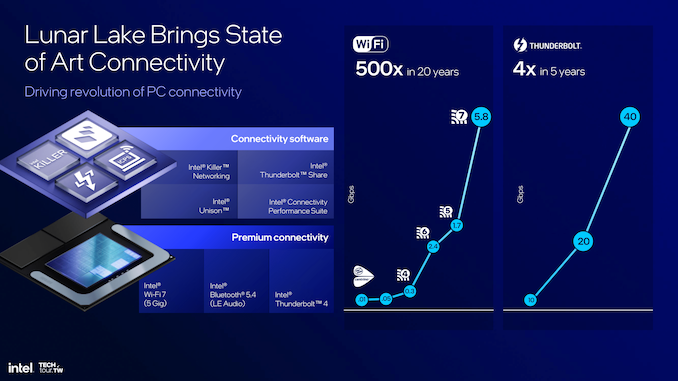
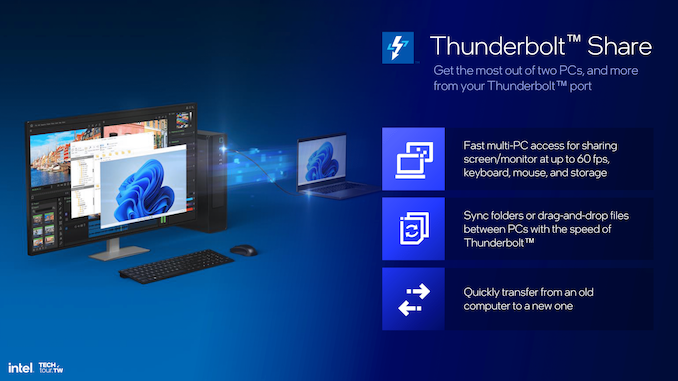
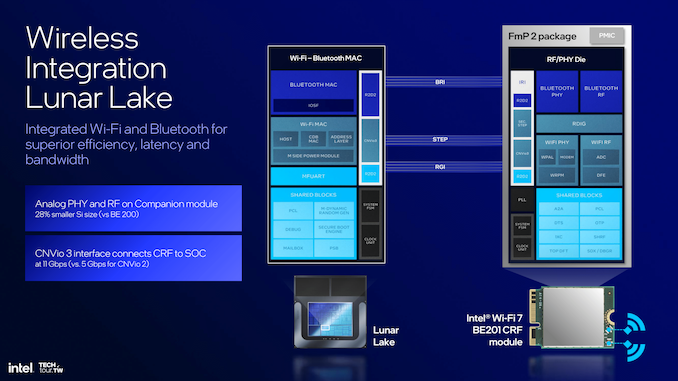
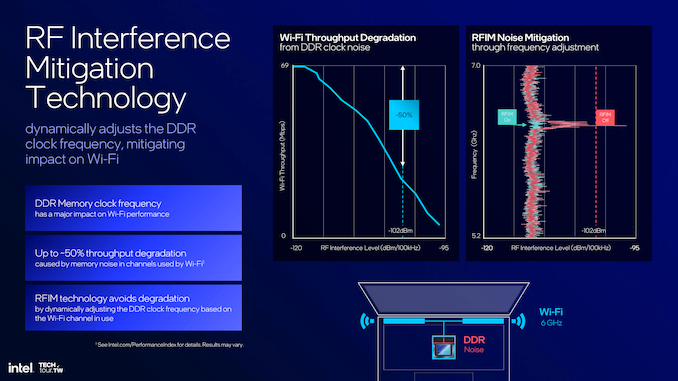
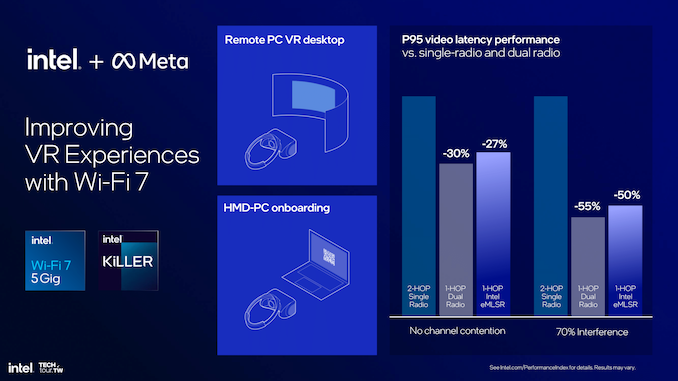








90 Comments
View All Comments
mode_13h - Tuesday, June 4, 2024 - link
Yeah, it definitely comes across as two-faced for Intel to be pitching its foundry business to others, while it's not even using it for its own cutting-edge CPUs! Replykn00tcn - Tuesday, June 4, 2024 - link
1) bob (or brian?) made a deal with tsmc and they need fill the required capacity2) tsmc chiplet packaging requires all tiles to come from tsmc (but mixing tile foundries is fine as long as someone else packages)
3) lunar lake isnt high power high core desktop/server, there's plenty else to make themselves, and obviously they've been ramping cutting edge future nodes
4) these things take years, why would a recent subsidy relate to old deals Reply
mode_13h - Thursday, June 6, 2024 - link
> 1) bob (or brian?) made a deal with tsmc and they need fill the required capacityThis is probably the dumbest claim I've seen in a while. There's guaranteed to be an escape clause in that contract, although Intel would be stuck with some fee.
Given the current demand for cutting-edge nodes, I'm sure Intel could probably work out an agreement with another fab customer to buy their excess wafer capacity and probably even turn a profit by it.
> 2) tsmc chiplet packaging requires all tiles to come from tsmc
Second dumbest claim in the thread. Lunar Lake uses Foveros, not TSMC's technology, and Intel is making the base layer on their own 22 nm node.
> 3) lunar lake isnt high power high core desktop/server
What does that have to do with anything? It still needs to compete on performance and efficiency!
> why would a recent subsidy relate to old deals
Who said anything about that? Reply
kwohlt - Tuesday, June 4, 2024 - link
Intel's foundry service doesn't have a full suite of nodes to choose from and is currently building out a fabs. In the meantime, client will be using some of the TSMC N3B allocation that Intel carved out years ago. Expect 2024-2025 to be peak TSMC usage.What other options were realistically available? Intel 3 is just hitting the market and fully allocated to Xeon 6 initially. Intel 4 isn't library complete and wouldn't work for a tile that also contains NPU and GPU. Intel 7 is heavy DTCO'd for ADL/RPL and has poor low wattage performance. 18A isn't ready yet.
By the time 14A releases, Intel will have a selection of 18A and the Intel 3 family of nodes to pick from for their other CPU tiles. Reply
mode_13h - Thursday, June 6, 2024 - link
> Intel 3 is just hitting the market and fully allocated to Xeon 6 initiallyThe Lunar Lake CPU tiles can't be very big. They should've been a good "pipe cleaner" product for Intel to ramp up their "3" node, before making the huge Xeon dies.
I hadn't noticed the GPU was on the same tile. If true, I think they could've kept it on its own tile, as Meteor Lake did. Reply
lmcd - Wednesday, June 12, 2024 - link
Intel has not shipped an Xe product on an Intel process since DG1. We don't know that it ports.Adding a separate die might have increased the package size, and part of the point of this product was to be a small package that could supplant Qualcomm designs easily (and the PMIC callout was specifically targeted at vendors that got burned by Qualcomm's power shenanigans, if you believe Charlie). Reply
andrewaggb - Thursday, June 6, 2024 - link
yeah, it's not a great look on the fab side, but honestly I hope it's an amazing chip and worth upgrading. I hope Qualcomm's chip is great as well and get some actual innovation/competition going on. Replyeonsim - Tuesday, June 4, 2024 - link
Is Intel comparing there new E-cores to the LP-E cores here (the ones on the SoC with no L3), rather than the main E-cores for Meteor lake? Replymode_13h - Tuesday, June 4, 2024 - link
+1 Replyname99 - Wednesday, June 5, 2024 - link
Exactly.And judging from what I've seen on the internet, plenty of people were fooled. And don't like to be told that they were fooled... Reply